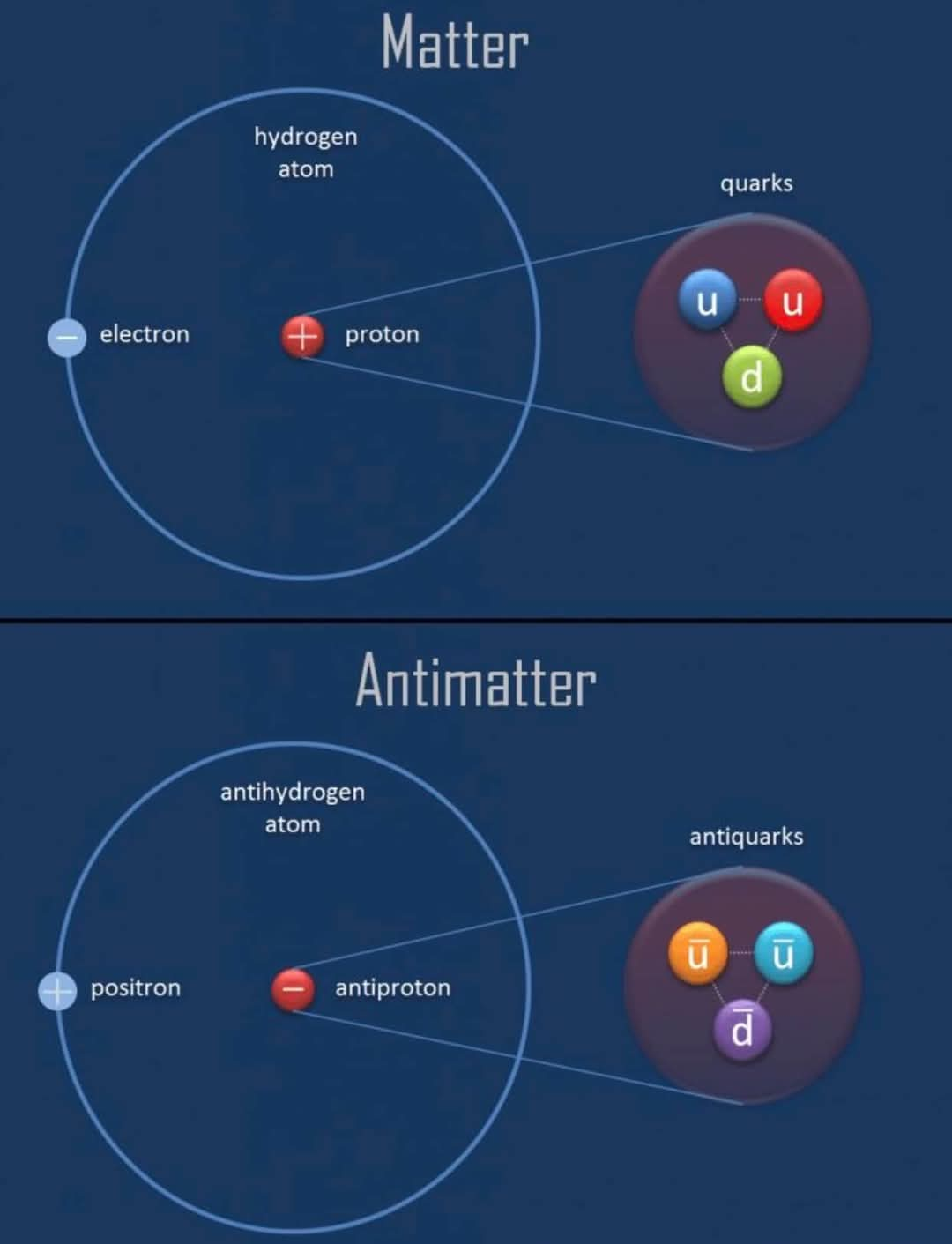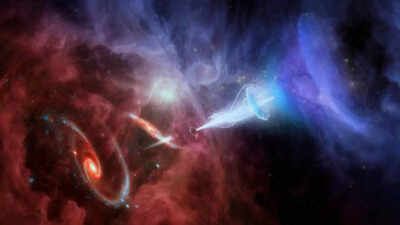about matter and antimatter, and the extinction of the pair
물질(Matter): 질량을 가지고 공간을 차지하며, 전자, 양성자, 중성자와 같은 입자로 구성됩니다. 우리 주변의 모든 물체는 물질로 이루어져 있습니다. 예를 들어, 책상, 의자, 공기, 심지어 우리 몸도 모두 물질입니다.
반물질(Antimatter): 물질과 같은 질량을 가지지만, 전하가 반대인 입자로 구성됩니다. 물질의 입자에 해당하는 반입자는 다음과 같습니다:
- 전자(Electron): 음전하를 띤 입자 -> 양전자(Positron): 양전하를 띤 입자
- 양성자(Proton): 양전하를 띤 입자 -> 반양성자(Antiproton): 음전하를 띤 입자
- 중성자(Neutron): 전하를 띠지 않는 입자 -> 반중성자(Antineutron): 전하를 띠지 않는 입자 (하지만 다른 양자수가 반대)
쌍소멸(Annihilation): 물질과 반물질이 만나면 서로를 상쇄하며, 엄청난 에너지를 방출하는 현상입니다. 이때 질량은 에너지로 완전히 전환됩니다. 아인슈타인의 유명한 공식 E=mc²에서 보듯이, 질량(m)과 에너지(E)는 비례 관계에 있습니다. 쌍소멸 과정에서 방출되는 에너지는 감마선(gamma rays) 형태로 나타납니다.
요약: 물질과 반물질은 서로의 반대 입자이며, 만나면 쌍소멸을 통해 에너지를 방출합니다. 이 현상은 물리학에서 중요한 개념이며, 우주 생성 초기와 관련된 연구에 활용됩니다. 반물질은 극소량만 존재하며, 생성과 저장이 어렵습니다.

Description of matter and antimatter, and diposition.
Matter: It has mass and occupies space, and is composed of particles such as electrons, protons, and neutrons. Every object around us is made up of matter, for example desks, chairs, air, even our bodies, all of which are matter.
Antimatter: It consists of particles with the same mass as the material, but with opposite charges. The antiparticle corresponding to the particles of the material is as follows:
- Electron: Negatively charged particles -> Positron: Positron: Positron: Positron
- Proton: positively charged particles -> Antiproton: negatively charged particles
- Neutron: uncharged particles -> Antineutron: uncharged particles (but other quantum numbers are opposite)
Annihilation: When matter and antimatter meet, they cancel each other out and release enormous energy. At this time, the mass is completely converted into energy. As seen in Einstein's famous formula E=mc2, mass (m) and energy (E) are proportional. The energy emitted during the bimodal extinction process appears in the form of gamma rays.
Summary: Matter and antimatter are opposite particles of each other, and when they meet, they release energy through bimodal extinction. This phenomenon is an important concept in physics and is used in research related to the early days of cosmic creation. Antimatter exists in very small amounts, and it is difficult to create and store.
(Add)

While antimatter is incredibly rare in the observable universe, it's not entirely absent. Its presence is primarily detected indirectly through its annihilation with matter, resulting in characteristic high-energy radiation.
Detection Methods and Locations:
The most common way we detect antimatter is through the detection of annihilation events. When a particle of matter and its corresponding antiparticle collide, they annihilate each other, converting their mass into energy in the form of gamma rays and other high-energy particles. These annihilation events are observed in several locations:
- Cosmic Rays: High-energy cosmic rays colliding with atoms in Earth's atmosphere produce small amounts of antiparticles, such as positrons (anti-electrons). These are relatively low-energy antiparticles compared to those potentially originating from other sources .
- Active Galactic Nuclei (AGN): Some theories suggest that AGN, powered by supermassive black holes, could be sources of antimatter. The intense energy processes within AGN might produce antiparticles, though direct observation remains challenging.
- Supernova Remnants: The explosive deaths of massive stars (supernovae) are another potential source of antimatter. The extreme energy released during a supernova could create antiparticles .
- Thunderstorms: Surprisingly, terrestrial gamma-ray flashes (TGFs) associated with thunderstorms have been linked to the production of positrons. The exact mechanisms are still under investigation .
The Antimatter Mystery:
A major unsolved problem in cosmology is the apparent asymmetry between matter and antimatter in the universe. The Big Bang theory predicts that equal amounts of matter and antimatter should have been created. However, the universe we observe is overwhelmingly composed of matter. The small amounts of antimatter detected are insufficient to explain this imbalance. Several hypotheses attempt to address this, including the possibility of regions dominated by antimatter that are yet to be discovered. The search for these regions and a deeper understanding of antimatter production mechanisms continues to be a significant area of research .
Artificial Production:
While naturally occurring antimatter is rare, it can be created in controlled environments, such as particle accelerators at facilities like CERN. However, the quantities produced are minuscule and extremely costly to generate and maintain .
❤️ 사랑과 연민의 다리 ❤️ about matter and antimatter, and the extinction of the pair . . . .